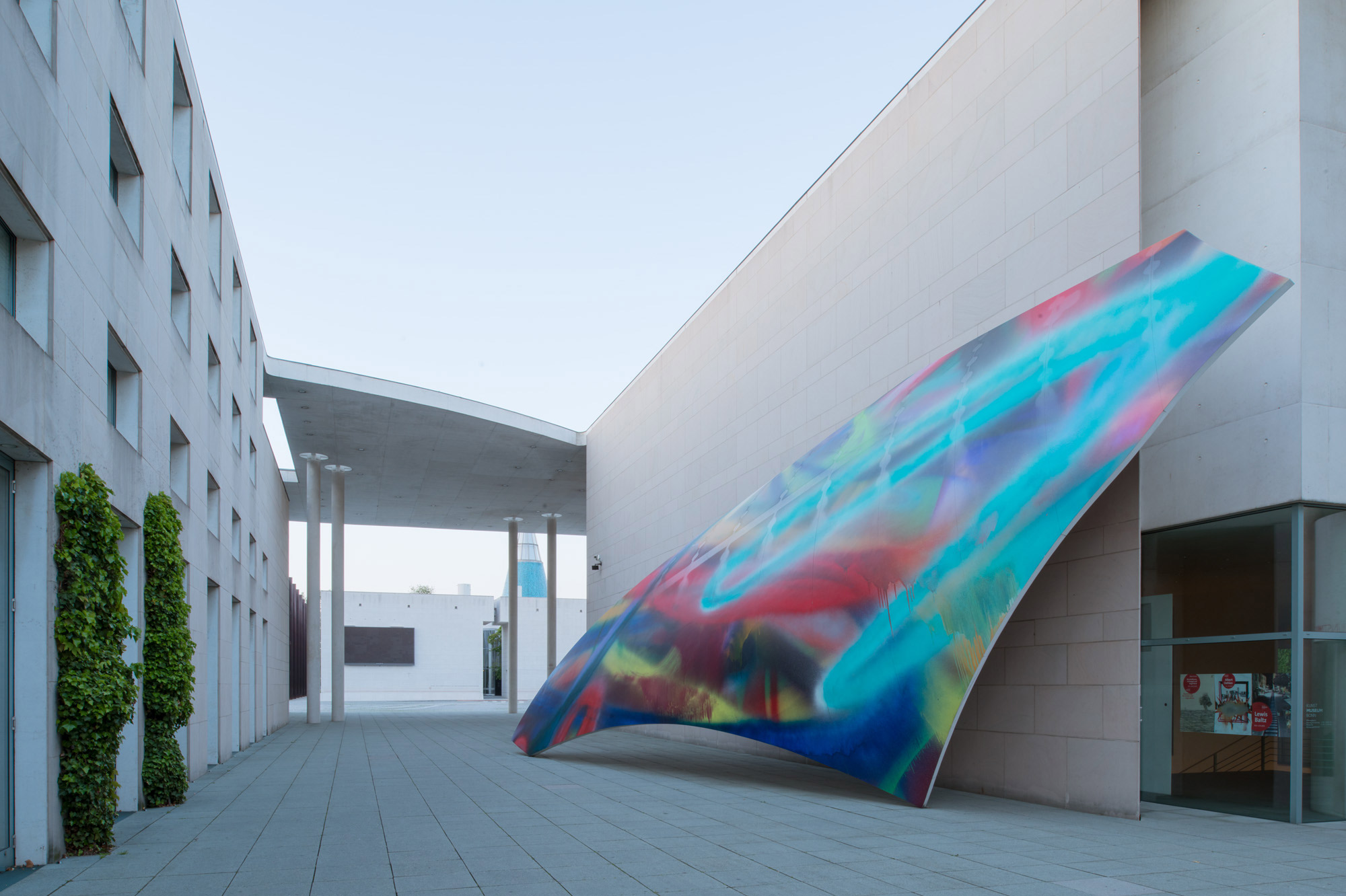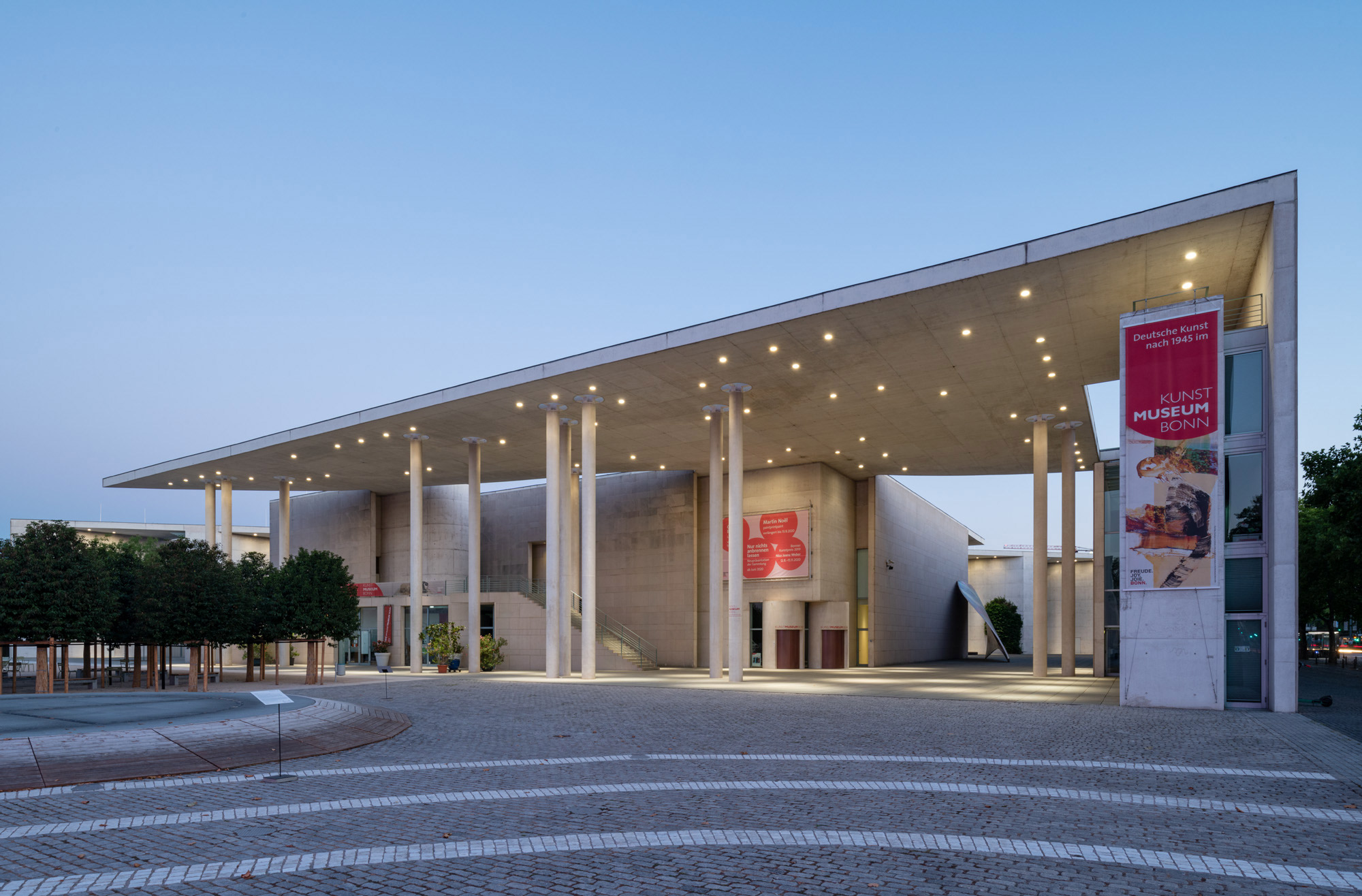
Photo: Andreas Klein
The museum
The Kunstmuseum Bonn numbers among the large, nationally-esteemed museums dedicated to contemporary art. Its new building, designed by the Berlin architect Axel Schultes and opened in 1992, is considered throughout Germany to be one of the most important examples of museum architecture in recent decades.
The institution is centered around a collection of some 9,000 works, with an extensive group of works by August Macke and a focus on the art of the Rhenish Expressionists, as well as the important collection of art in Germany after 1945 with an emphasis on painting, photography and time-based media. A special feature of this profile, unique in the Federal Republic, is the concentration on a manageable number of outstanding artists whose works are displayed in large-scale artist’s rooms.
The internationally oriented, thematic and monographic exhibition projects are generally developed out of a close connection to the context of the collection.With the working area “Education and Outreach,” the Kunstmuseum Bonn attracts new circles of visitors and fulfills the sociopolitical responsibilities required of an up-to-date museum and art outreach program, through qualified and multifaceted pedagogical offerings which have a crucial role to play in the framework of recreational and educational opportunities in Bonn.
Moreover, wide-ranging collaborations with various institutions in a local and regional context firmly anchor the institution in the awareness of a broad public.
History
The planning of a new domicile for the municipal art museum, which until the beginning of the 1990s had been housed more or less provisionally in a converted office building in the Rathausgasse, began at the start of the 1980s as part of an overall concept for erecting federal cultural buildings in Bonn, which at that time was the capital of the country. In 1985, the city of Bonn announced a two-phase architectural competition which also included ideas for the planned Bundeskunsthalle. Both buildings, in spite of their different institutions, were intended to form an ensemble and to be connected with each other through what is today called the “Museumsplatz.”
Construction of the Kunstmuseum Bonn commenced in 1985 by the winner of the competition, the architectural office BJSS—Dietrich Bangert, Bernd Jansen, Stefan Scholz, Axel Schultes—and Jürgen Pleuser.
The actual collecting history of the Kunstmuseum Bonn, which arose originally out of the private Obernier Collection, began in 1949 with the acquisition of the Türkisches Café (1914) and the Seiltänzer (1914), both works by August Macke.
Together with works by the Rhenish Expressionists and an extensive group of works by Max Ernst, the works by Macke constitute the foundation of the collection and served as the basis for the collection’s concentration on the medium of painting. Bonn’s status over many years as the federal capital served as a further impetus to pursue this collecting orientation above all with regard to art created in Germany. Thus during the last six decades, one of the internationally most significant collections of art in Germany arose, with the occasional acquisition of entire groups of works by renowned artists. Into the 1990s, the museum was above all a site for painting whereas, under the directors Dieter Ronte and Stephan Berg, the focus expanded and has come to include all media—not only in the collection, but also in the consistently internationally oriented temporary exhibitions.
Directors
Walter Holzhausen 1947-1961
Eberhard Marx 1962-1976
Dierk Stemmler 1977-1985
Katharina Schmidt 1985-1992
Dieter Ronte 1993-2008
Stephan Berg seit 2008
Architecture
Not only because of its collection, but also due to its outstanding architecture, the Kunstmuseum Bonn is an important cultural “lighthouse” in the Federal City of Bonn and radiates a national and international charisma.
The building planned in the mid-1980s by a team of architects—Dietrich Bangert, Bernd Jansen, Stefan Scholz and Axel Schultes (BJSS)—was opened in June 1992. As a component of the Bonn Museum Mile, the architecture is convincing through its openness and handling of light. The clear but in no way sober formal language, which definitely contains playful components, never succumbs to a self-infatuated celebration of architecture.Indebted in its size to the spirit of the late 1980s, the building instead optimally conjoins a vigorous formal language that is all its own with the contentual requirements of the institution.
With its ambitious, “flowing” spatial concept, the museum—with respect to both the dimensions of the individual spaces, their visual and material axes of access and the handling of light—offers impressive preconditions for achieving an optimal presentation of art in all its facets, from classic modernism all the way to the varieties of the most recent contemporary art.

SUSTAINABILITY
Collection & Exhibitions
- Stronger focus on own collection
- Fewer international loans and pooling of art transports, thereby eliminating CO2-emitting art transports
- Land instead of air transports
- Longer exhibition runtimes
- Avoidance of domestic air travel for business trips
- Use of a reusable partition wall system for exhibition architecture (recycling of materials)
Education
- Education for sustainable development (ESD) in the focus of conception and implementation of educational offers for day-care centers and schools
- Resource-conscious use of materials in workshops
Administration
- Compliance with environmental and climate protection standards in awarding contracts: Consideration of sustainability, social standards and environmental protection criteria in the procurement of goods, construction work and services.
Material
- Conserving resources and reducing waste by reusing materials (packaging materials for artwork, bases, fabrics, papers, etc.)
- Printed materials
- Project-related digital instead of printed exhibition catalogs
- In the case of printed exhibition catalogs, the aim is to avoid individually shrink-wrapping the catalog in plastic
Energy
- Replacement of light bulbs with LED lighting (from 2023)
- Cooperation with the climate initiative Art to Acres: CO2 emissions caused by the exhibitions are offset in cooperation with Art to Acres and the “Freunde” of the Kunstmuseum Bonn e.V. (conversion of forest areas into landscape conservation areas). Further information at: https://www.arttoacres.org/
Perspectives
- Preparation of further measures by the Sustainability Working Group







